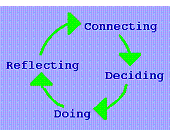|
from The Worldview Literacy Book copyright 2009 back to worldview theme #13 |
| Discussion
Separated from their surroundings by a boundary—mass, energy,
and information flow both into and out of a system. These are also
transferred within the system between its component parts. While examples of systems can be found everywhere
throughout the natural, manmade, and conceptual worlds, they vary
greatly in complexity.
In the natural world, cells, an animal's circulatory system, the
human brain, eco-systems, and the Earth can be understood as systems.
In the manmade world, we can similarly consider household cooling
systems, automobile braking systems, computers, automobiles, and
buildings. In the
conceptual realm, computer models simulate real systems that exist in
natural and manmade realms along with parts of the human societal
framework. Examples
include models of traffic flow in a city, a public social
security system, and a national economy.
Many terms can be used to name, characterize and distinguish
systems, including control, feedback (see Figures #13b, 13c, 31b),
dynamic, linear, non-linear, chaotic, complex, hard, soft, and
evolutionary.
As the above examples suggest, many systems are themselves
composed of systems (called subsystems).
Particularly complex systems may have many levels of
organization. Consider the
Earth. Studying its living
things can be done at various levels: from whole biosphere perspective,
to ecosystem, community, habitat, population, organism, organ, tissue,
cell, down to the level of molecules inside cells.
Sometimes, in seeking to
understand systems at different levels, unexpected
properties emerge when higher levels of complexity are considered—
properties that can't be predicted from lower level considerations.
It seems the whole system is not equal to the sum of its parts!
An example of an emergent property would be if the Earth were
found to be alive and functioning as a single living organism (the Gaia
hypothesis, which few take seriously!)
Some connect emergence with God's work.
Rather than using old fashioned analytical, reductionist
techniques for such investigation, computer models do a better job.
Indeed, constructing a program that inputs properties of a
system's lower level component parts and uses understanding of how the
system functions to predict behavior (provide output) at a higher level
is a useful tool for discovering unexpected system behavior.
Or the process can work the other way: sometimes system behavior
present at one level isn't under-stood based on the understanding of
processes occurring at the lower level.
The details of how spiral arms form in galaxies were unraveled in
this manner. Perhaps the
ultimate related "emergent properties" type problem is
"How does human consciousness arise?"
In both investigating how the brain works and the development of
artificial intelligence,
neural
network computer models,
|
Discussion—continued which like
the brain learn from experience, are often employed. Computer
models and systems thinking are increasingly applied to human societal
problems. Economists use
these tools to simulate and understand nearly every conceivable aspect
of the free market system. It
isn't an exaggeration to say billions of dollars are often staked on the
predictions that emerge from their models.
While models relevant to economic concerns have become
increasingly important, so have those relevant to environmental concerns
(Figure #13c). Indeed,
after inputting "business as usual" trends, output from models
of the Earth's energy balance (predicted future global temperatures) is
already redirecting billions of dollars of economic investment.
Human society is steadily being better understood, shaped,
and in some cases redesigned by modeling the social
systems involved. Given the
complexity of many of these systems, the fact that key aspects of them
often are "soft" and can't even be quantified, at some point
what systems thinkers do becomes less science and more art. "Dancing With Systems" is what Donella Meadows,
who inspired this theme, called it.
Meadows was a protégée of MIT's Jay Forrester—as was Peter
Senge. Senge pioneered in
applying systems thinking to how organizations can learn and
adapt—something he called "The Dance of Change."
He recognized that learning relies on a feedback loop (see Figure #13a): a system with inputs (perceptions,
reflections), outputs (actions taken), feedback and inter-relations.
Realizing that the key aspect of organizational learning is the
interaction between its individuals, Senge's 1990 book The Fifth
Discipline identifies five learning disciplines to promote the
desired group problem solving.
In summarizing these disciplines he writes, "Building shared
vision fosters a commitment to the long term.
Mental models focus on the openness needed to unearth
shortcomings in our present ways of seeing the world.
Team learning develops the skills of groups of people to look for
the larger picture that lies beyond individual perspectives. And personal mastery fosters the personal motivation to
continually learn how our actions affect our world. Lastly, systems
thinking makes understandable the subtlest aspect of the learning
organization—the new way individuals perceive themselves and their
world. At the heart of a
learning organization is a shift of mind—from seeing ourselves as
separate from the world to connected to the world, from seeing problems
as caused by someone or some-thing 'out there' to seeing how our own
actions create the problems we experience."
Senge thinks in terms of circles of causality, and writes,
"Reality is made up of circles, but we see straight lines.
Herein lie the beginnings of our limitation as systems
thinkers." |
|
Figure
#13a The
Learning Cycle 
|
Figure
#13c Positive
Feedback Loops in Global Climate Models 1)
Albedo Feedback: Albedo refers to the % incident sunshine that is
reflected back from a surface. As
global warming increases temperatures, highly reflective polar sea ice
melts--replaced by darker ocean water.
This lowering of the albedo results in more solar energy absorbed
(darker surfaces are better absorbers), higher temperatures, more ice
melting, etc. |
||
|
Figure #13b: Positive & Negative Feedback Loops
|
|||
